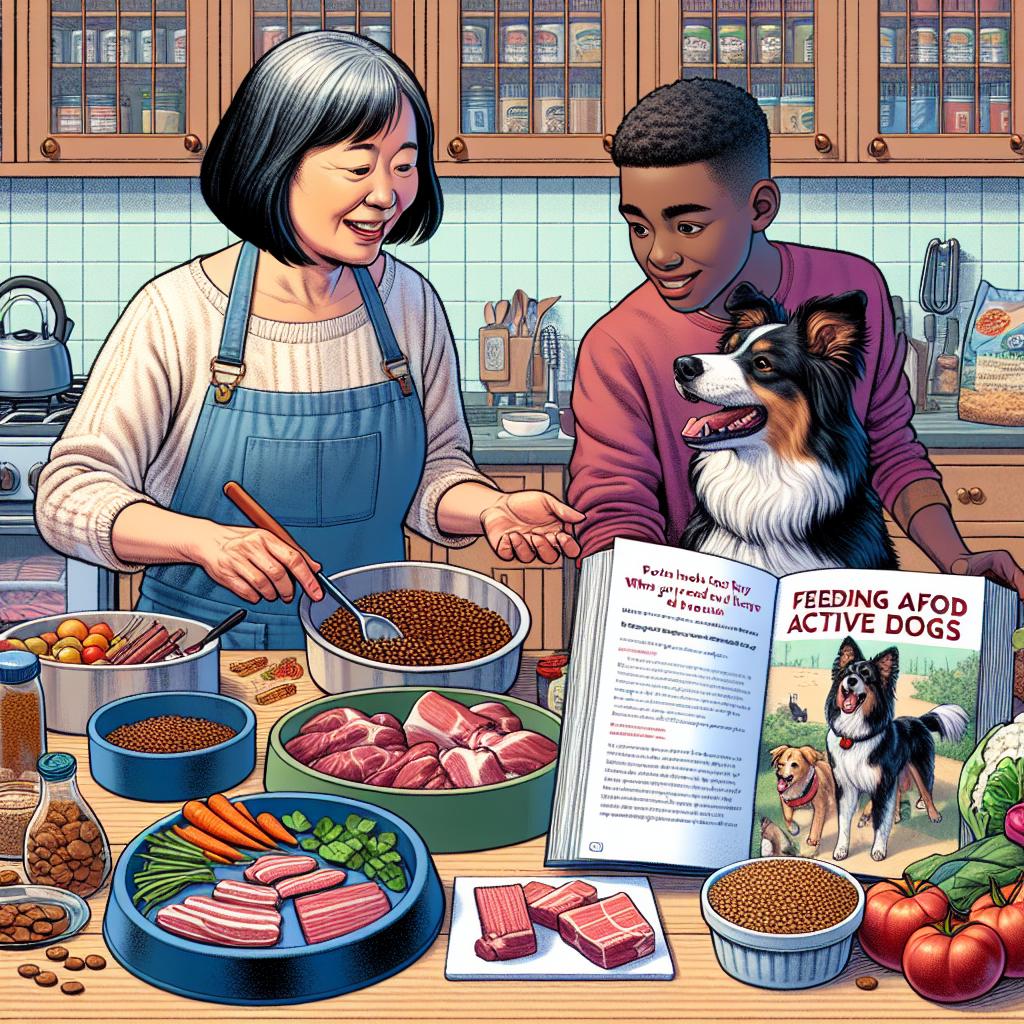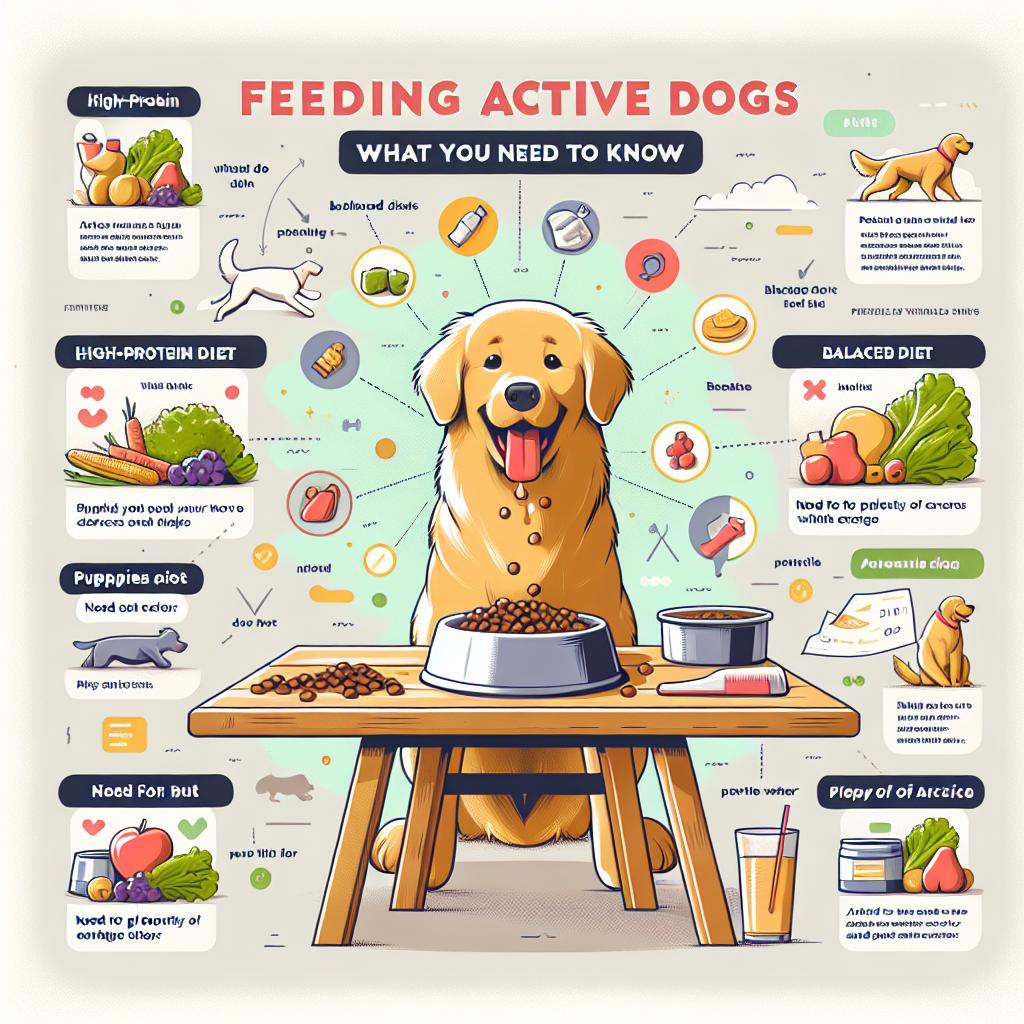Feeding Active Dogs: What You Need to Know
When it comes to our four-legged companions, few things bring as much joy as watching them bound across the backyard, their tails wagging in sheer delight. Active dogs are a vibrant testament to the spirit of playfulness and energy—qualities that make them not only loyal companions but also a source of inspiration for an active lifestyle. However, with all that enthusiasm comes an essential responsibility: ensuring these energetic beings receive the right nutrition to fuel their adventures. Feeding an active dog isn’t just about filling their bowls; it encompasses a deeper understanding of their unique dietary needs, energy requirements, and overall health.
In this article, we’ll explore the vital components of a well-balanced diet for energetic pooches, offering insights into the types of foods that can support their vigor and maintain their well-being. From the importance of high-quality proteins to the role of carbohydrates and fats, we’ll clarify the essential nutrients that keep tails wagging and spirits high. Join us as we delve into the world of canine nutrition, equipping you with the knowledge necessary to provide your active dog with the perfect fuel for their unstoppable antics.
Understanding the Unique Nutritional Needs of Active Dogs
Active dogs have distinct nutritional requirements that must be met to support their energy levels and overall well-being. Unlike more sedentary breeds, these energetic companions burn calories at a higher rate, necessitating a diet rich in essential nutrients. Key components to consider include:
- High-quality protein: Essential for muscle repair and development.
- Healthy fats: Important for energy and maintaining healthy skin and coat.
- Complex carbohydrates: Provide sustained energy for prolonged activities.
- Vitamins and minerals: Support various bodily functions, from immune health to bone strength.
To ensure that active dogs receive balanced nutrition, it’s crucial to select dog food specifically formulated for their lifestyle. The feeding guidelines may vary significantly based on their age, breed, and activity levels. Here’s a helpful overview:
| Dog Type | Daily Caloric Needs (approximately) | Recommended Protein Content |
|---|---|---|
| Working dogs | 1,500 – 2,500 kcal | 25% – 30% |
| Active sport dogs | 1,400 – 2,200 kcal | 20% – 25% |
| High-energy breeds (e.g., Border Collies) | 1,200 – 1,800 kcal | 22% – 28% |

Choosing the Right Ingredients for Peak Performance
When it comes to fueling your active dog’s performance, selecting the right ingredients is paramount. High-quality proteins are essential for muscle development and repair. Look for sources like chicken, beef, and fish to ensure that your pet receives adequate amino acids. Additionally, don’t overlook the importance of healthy fats, which provide sustained energy during physical activities. Ingredients such as salmon oil, flaxseeds, and coconut oil can greatly benefit endurance and coat health. Fillers, artificial preservatives, and low-quality grains can hinder your dog’s performance, so aim for a diet that prioritizes whole and recognizable ingredients.
Equally crucial are the carbohydrates that will give your dog the energy it needs. Opt for complex carbohydrates from sources like brown rice, sweet potatoes, and oats to provide lasting energy without the crashes associated with simple sugars. Hydration is also a key player in performance—always ensure fresh water is available. To simplify your ingredient choices, consider utilizing a chart like the one below to highlight the benefits of various components:
| Ingredient | Benefit |
|---|---|
| Protein | Supports muscle repair and development |
| Healthy Fats | Provides energy and maintains coat health |
| Complex Carbohydrates | Offers sustained energy for activities |
| Hydration | Essential for performance and recovery |

Tailoring Feeding Schedules to Optimize Energy Levels
To ensure your active dog maintains optimal energy levels throughout the day, it’s essential to customize their feeding schedule based on their activity patterns. Dogs that engage in high-energy activities, such as agility training or long hikes, often require a different approach compared to those with more moderate exercise routines. Consider implementing a feeding routine that aligns with their activity spikes. For instance, feeding your furry friend a nutritious meal about 1-2 hours before a workout can provide the necessary fuel, while a post-exercise meal helps in recovery.
Here are some effective strategies to help tailor your dog’s feeding schedule:
- Monitor Activity Levels: Track your dog’s energy demands and adjust meal times accordingly.
- Portion Control: Distribute the daily food intake into smaller, more frequent meals to sustain energy.
- Quality Ingredients: Choose high-quality, energy-dense foods that support their active lifestyle.
| Feeding Timing | Recommended Action |
|---|---|
| Pre-Activity | Feed 1-2 hours before exercise |
| Post-Activity | Provide recovery meal within 30 mins |
| Rest Days | Keep to regular feeding schedule |

Monitoring Health and Adjusting Diet for Active Lifestyles
Monitoring your dog’s health is crucial to ensuring they thrive in an active lifestyle. Regular vet check-ups can help identify potential health issues early, such as joint problems or obesity, which are common in active dogs. Keeping track of changes in weight or energy levels is equally important. If you notice your dog gaining weight despite regular exercise, it may be time to revisit their diet. Additionally, adjusting their food portion sizes according to their activity level can help maintain a healthy weight and provide them with the necessary energy to keep up with their daily adventures.
When it comes to dietary adjustments, consider incorporating the following elements to support your dog’s activity level:
- High Protein Content: Look for dog foods that list high-quality protein sources as the first ingredient.
- Balanced Nutrients: Ensure the diet includes healthy fats and carbohydrates to fuel their energy needs.
- Hydration: Always provide fresh water, as active dogs require plenty of hydration to stay healthy.
To simplify your decision-making, here is a quick comparison of popular dog food formulations suited for active dogs:
| Brand | Protein (%) | Fat (%) | Carbohydrates (%) |
|---|---|---|---|
| Brand A | 30 | 20 | 50 |
| Brand B | 28 | 25 | 47 |
| Brand C | 32 | 15 | 53 |
Q&A
Q&A: Feeding Active Dogs – What You Need to Know
Q1: Why is nutrition particularly important for active dogs?
Active dogs are like high-performance engines; they require the right fuel to function optimally. Proper nutrition supports their energy levels, aids in muscle recovery, and helps maintain overall health. Without the right nutrients, an active dog’s performance can falter, potentially leading to fatigue or injury.
Q2: What kind of diet should I consider for my active dog?
Generally, an active dog’s diet should be rich in high-quality protein, healthy fats, and carbohydrates. Look for dog foods that list real meats as the first ingredient. Additionally, healthy fats, such as omega-3 and omega-6 fatty acids, can provide the energy needed for sustained activity, while carbohydrates can help replenish energy stores after exercise.
Q3: How can I calculate how much food my active dog needs?
Start by considering your dog’s weight, activity level, and age. Many dog food brands offer feeding guidelines based on these factors. A good rule of thumb is to adjust the serving size according to your dog’s energy expenditure. If your dog is working out or playing hard, you may need to provide an extra portion. Conversely, during rest periods, scale back accordingly.
Q4: Are there specific supplements I should consider?
While most well-balanced commercial dog foods contain essential nutrients, some active dogs may benefit from supplements such as glucosamine for joint health, omega fatty acids for coat, and skin health, or probiotics for digestive support. However, it’s best to consult your veterinarian before adding any supplements to ensure they are appropriate for your dog’s specific needs.
Q5: How often should I feed my active dog?
Active dogs often benefit from more frequent meals. Depending on their exercise routine, two to three meals a day can be ideal. This helps maintain energy levels and prevents bloating, particularly in large breeds. Keep in mind, feeding just before intense activity can lead to discomfort, so timing your meals around your dog’s exercise schedule is crucial.
Q6: Can I offer treats to my active dog, and if so, what kind?
Treats can definitely be part of your active dog’s diet, but it’s important to choose them wisely! Look for treats that are low in calories but high in protein to complement their meals. You can also use treats as a reward during training sessions or after a good workout, but be mindful of the total caloric intake to ensure it doesn’t exceed their daily requirements.
Q7: How can I tell if my dog is getting the right nutrition?
The best indicators of proper nutrition in your dog include a shiny coat, clear eyes, healthy skin, consistent energy levels, and a maintained body weight. If you notice changes in your dog’s skin, coat, or energy levels, it may be time to reassess their diet or consult your veterinarian for tailored advice.
Q8: What should I avoid feeding my active dog?
Steer clear of feeding your dog human food that can be harmful to them, such as chocolate, grapes, onions, or high-fat meats. Additionally, avoid foods high in fillers or artificial additives. Too many calories or low-quality foods can lead to weight gain and health issues, which can impede your dog’s active lifestyle.
Q9: Is hydration important for active dogs, and how can I ensure they stay hydrated?
Absolutely! Hydration is just as vital as proper nutrition, especially for active dogs. Always provide fresh water for your dog and be mindful of their water intake, particularly after exercise. During outdoor activities, consider taking a portable bowl and some water with you to encourage hydration breaks.
Q10: When should I consult a veterinarian about my dog’s diet?
If you’re ever in doubt about your dog’s nutritional needs, have concerns about their weight, or notice any changes in behavior or health, consulting your veterinarian is always a wise choice. They can provide tailored advice based on your active dog’s specific requirements.
Remember, feeding an active dog is both an art and a science—balancing proper nutrition with the love and care they deserve!
In Retrospect
nourishing an active dog requires more than just filling their bowl with food; it’s about understanding their unique energy needs, nutritional requirements, and feeding patterns. By carefully selecting high-quality ingredients, adjusting portion sizes based on activity levels, and incorporating a well-balanced diet, you can help your furry companion thrive. Remember, each dog is an individual, with specific needs that vary by breed, age, and lifestyle. Regular consultations with a veterinarian or canine nutritionist can provide tailored guidance that ensures your active dog remains healthy, vibrant, and ready for the adventures that lie ahead. Armed with knowledge and a passion for your pet’s well-being, you’ll not only foster their energy and vitality but also deepen the bond you share, making every moment spent together a joyful one. Here’s to many happy trails and wagging tails!

